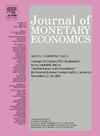Who bears the costs of inflation? Euro area households and the 2021–2023 shock
IF 4.3
2区 经济学
Q1 BUSINESS, FINANCE
引用次数: 0
Abstract
We measure the heterogeneous first-order welfare effects of the recent inflation surge across households in the euro area. A simple framework illustrating the numerous transmission channels of surprise inflation to household welfare guides our empirical exercise. By combining micro data and aggregate time series, we conclude that: (i) country-level average welfare costs – expressed as a share of triennial income – were sizable and heterogeneous: around 3% in France and Spain, 7% in Germany, and 9% in Italy; (ii) this inflation episode resembles an age-dependent tax, with the retirees losing up to 14%, and roughly half of the 25–44 year-old winning; (iii) losses were quite uniform across consumption quantiles because rigid rents served as a hedge for the poor; (iv) nominal net positions were the key driver of heterogeneity across-households; (v) the rise in energy prices generated vast variation in individual-level inflation rates, but unconventional fiscal policies helped shield households. The counterpart of this household-sector loss is a significant gain for the government.
谁来承担通货膨胀的成本?欧元区家庭与 2021-2023 年冲击
我们测算了近期通胀飙升对欧元区不同家庭的一阶福利影响。一个简单的框架说明了意外通胀对家庭福利的众多传导渠道,为我们的实证研究提供了指导。结合微观数据和总体时间序列,我们得出以下结论(i) 国家层面的平均福利成本--以三年期收入的比例表示--相当可观且各不相同:在法国和西班牙约为 3%,在德国为 7%,在意大利为 9%;(ii) 这一通胀事件类似于与年龄相关的税收,退休人员的损失高达 14%,25-44 岁人群的损失约占一半;(iii) 不同消费数量级的损失相当一致,因为刚性租金对穷人起到了对冲作用;(iv) 名义净头寸是家庭间异质性的主要驱动因素;(v) 能源价格的上涨导致个人层面的通胀率差异巨大,但非常规的财政政策有助于保护家庭。与家庭部门的损失相对应的是政府的巨大收益。
本文章由计算机程序翻译,如有差异,请以英文原文为准。
求助全文
约1分钟内获得全文
求助全文
来源期刊

Journal of Monetary Economics
Multiple-
CiteScore
7.20
自引率
4.90%
发文量
90
审稿时长
74 days
期刊介绍:
The profession has witnessed over the past twenty years a remarkable expansion of research activities bearing on problems in the broader field of monetary economics. The strong interest in monetary analysis has been increasingly matched in recent years by the growing attention to the working and structure of financial institutions. The role of various institutional arrangements, the consequences of specific changes in banking structure and the welfare aspects of structural policies have attracted an increasing interest in the profession. There has also been a growing attention to the operation of credit markets and to various aspects in the behavior of rates of return on assets. The Journal of Monetary Economics provides a specialized forum for the publication of this research.
 求助内容:
求助内容: 应助结果提醒方式:
应助结果提醒方式:


